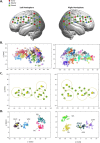Having a chat and then watching a movie: how social interaction synchronises our brains during co-watching
- PMID: 38707237
- PMCID: PMC11069416
- DOI: 10.1093/oons/kvae006
Having a chat and then watching a movie: how social interaction synchronises our brains during co-watching
Abstract
How does co-presence change our neural experience of the world? Can a conversation change how we synchronise with our partner during later events? Using fNIRS hyperscanning, we measured brain activity from 27 pairs of familiar adults simultaneously over frontal, temporal and parietal regions bilaterally, as they co-watched two different episodes of a short cartoon. In-between the two episodes, each pair engaged in a face-to-face conversation on topics unrelated to the cartoon episodes. Brain synchrony was calculated using wavelet transform coherence and computed separately for real pairs and shuffled pseudo) pairs. Findings reveal that real pairs showed increased brain synchrony over right Dorso-Lateral Pre-Frontal cortex (DLPFC) and right Superior Parietal Lobe (SPL), compared to pseudo pairs (who had never seen each other and watched the same movie at different times; uncorrected for multiple comparisons). In addition, co-watching after a conversation was associated with greater synchrony over right TPJ compared to co-watching before a conversation, and this effect was significantly higher in real pairs (who engaged in conversation with each other) compared to pseudo pairs (who had a conversation with someone else; uncorrected for multiple comparisons). The present study has shed the light on the role of social interaction in modulating brain synchrony across people not just during social interaction, but even for subsequent non-social activities. These results have implications in the growing domain of naturalistic neuroimaging and interactive neuroscience.
Keywords: Brain-to-brain synchrony; cowatching; fNIRS hyperscanning; social interaction; wavelet coherence.
© The Author(s) 2024. Published by Oxford University Press.
Conflict of interest statement
The authors declare no competing interests.
Figures






Similar articles
-
Frontal temporal and parietal systems synchronize within and across brains during live eye-to-eye contact.Neuroimage. 2017 Aug 15;157:314-330. doi: 10.1016/j.neuroimage.2017.06.018. Epub 2017 Jun 12. Neuroimage. 2017. PMID: 28619652 Free PMC article.
-
Social risky decision-making reveals gender differences in the TPJ: A hyperscanning study using functional near-infrared spectroscopy.Brain Cogn. 2017 Dec;119:54-63. doi: 10.1016/j.bandc.2017.08.008. Epub 2017 Sep 8. Brain Cogn. 2017. PMID: 28889923
-
Distributed Neural Activity Patterns during Human-to-Human Competition.Front Hum Neurosci. 2017 Nov 23;11:571. doi: 10.3389/fnhum.2017.00571. eCollection 2017. Front Hum Neurosci. 2017. PMID: 29218005 Free PMC article.
-
Quantification of inter-brain coupling: A review of current methods used in haemodynamic and electrophysiological hyperscanning studies.Neuroimage. 2023 Oct 15;280:120354. doi: 10.1016/j.neuroimage.2023.120354. Epub 2023 Sep 4. Neuroimage. 2023. PMID: 37666393 Review.
-
The integration of social and neural synchrony: a case for ecologically valid research using MEG neuroimaging.Soc Cogn Affect Neurosci. 2021 Jan 18;16(1-2):143-152. doi: 10.1093/scan/nsaa061. Soc Cogn Affect Neurosci. 2021. PMID: 32382751 Free PMC article. Review.
Cited by
-
Arbitrary methodological decisions skew inter-brain synchronization estimates in hyperscanning-EEG studies.Imaging Neurosci (Camb). 2024 Nov 1;2:imag-2-00350. doi: 10.1162/imag_a_00350. eCollection 2024. Imaging Neurosci (Camb). 2024. PMID: 40800335 Free PMC article.
-
Caregiver-child neural synchrony: Magic, mirage, or developmental mechanism?Dev Cogn Neurosci. 2025 Jan;71:101482. doi: 10.1016/j.dcn.2024.101482. Epub 2024 Nov 29. Dev Cogn Neurosci. 2025. PMID: 39693894 Free PMC article. Review.
-
Impacts of Kinematic Information on Action Anticipation and the Related Neurophysiological Associations in Volleyball Experts.Brain Sci. 2024 Jun 27;14(7):647. doi: 10.3390/brainsci14070647. Brain Sci. 2024. PMID: 39061388 Free PMC article.
References
-
- Azhari A, Bizzego A, Esposito G. Father-child dyads exhibit unique inter-subject synchronization during co-viewing of animation video stimuli. Soc Neurosci 2021;16:522–33 - PubMed
-
- Azhari A, Bizzego A, Esposito G. Parent–child dyads with greater parenting stress exhibit less synchrony in posterior areas and more synchrony in frontal areas of the prefrontal cortex during shared play. Soc Neurosci 2022;17:520–31 - PubMed
-
- Balconi M, Gatti L, Vanutelli ME. When cooperation goes wrong: brain and behavioural correlates of ineffective joint strategies in dyads. Int J Neurosci 2018;128:155–66 - PubMed
LinkOut - more resources
Full Text Sources
